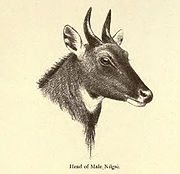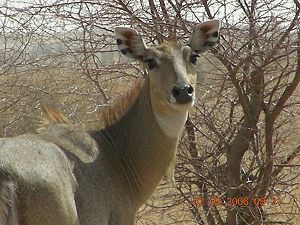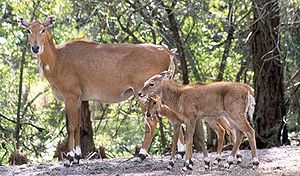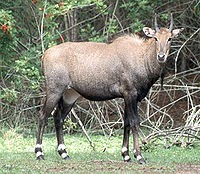
Nilgai
Encyclopedia
The nilgai sometimes called nilgau, is an antelope
, and is one of the most commonly seen wild animals of central and northern India
and eastern Pakistan
; it is also present in parts of southern Nepal
. The mature males appear ox
-like and are also known as blue bulls. The nilgai is the biggest Asian antelope.
 Calves usually weigh 13.6-15.9 kilograms (30-35 pounds) at birth after an 8 month gestation period. Over 60% of births result in twins, though births of 1 or 3 do occur. They reach sexual maturity at around 18 months and can live as long as 21 years.
Calves usually weigh 13.6-15.9 kilograms (30-35 pounds) at birth after an 8 month gestation period. Over 60% of births result in twins, though births of 1 or 3 do occur. They reach sexual maturity at around 18 months and can live as long as 21 years.
Nilgai have thin legs and a robust body that slopes down from the shoulder. Their long, narrow heads are topped by two small conical horns which are straight and tilted slightly forward. Horns on trophy males are normally 21.6-25.4 centimeters (8.5-10 inches). They have an erectile mane on the back of the neck and a tubular shaped "hair pennant" on the midsection of the throat. They have a small triangular tail which moves with a very high frequency when they are excited.
Female nilgai have a short yellow-brown coat. Males' coats gradually darken to a grey-blue as they reach maturity. They have white spots on the cheeks and white coloring on the edges of the lips. They also have a white throat bib and a narrow white stripe along the underside of the body that widens at the rear.
Nilgai can be found in single sex or mixed sex herds of 4-20, although old bulls are sometimes solitary.
in the north, down to the state of Karnataka
in the South, and from the Gir
forest and from all along the entire eastern length of Pakistan
and over across the border of Rajasthan
in the West to the states of Assam
and West Bengal
in the East; in Nepal, they occur patchily in the southern lowlands. The population density in central India is 0.07 animals per square kilometer.
 Historic notes mention the nilgai in southern parts of India but there have also been suggestion that they may be a feral population.
Historic notes mention the nilgai in southern parts of India but there have also been suggestion that they may be a feral population.
Refer to Anderson on shikar in southern India. Nilgai have existed north of Bangalore and probably still do.
Nilgai were introduced in the US state of Texas
in the 1920s by the King Ranch for recreational purposes. Over the years some escaped and they are now free ranging in various southern portions of the state.
and live in grasslands and woodlands where they eat grasses, leaves
, buds, and fruit
.
In the wild, females and young males gather in herds of about fifteen individuals while older males are often solitary. Individual male or female nilgai may be encountered in cultivated or semi-urban areas.
A blue bull is called a nil gai or nilgai in India, literally from nil meaning blue and gai meaning a bovine animal (literally 'cow'). In fact nilgai were known as the Nilghor (nil = blue , ghor = horse) during the rule of Aurangzeb
(Mughal Era) (Gautam Masters dissertation unpubl : Dept. of Wildlife Sciences, Aligarh Muslim Univ). Nevertheless the local belief, that nilgai are a cow and hence sacred, has protected it against hunting.
However, nilgai are a crop menace, causing large-scale damages especially along the gangetic belt, especially in the Rohilkhand division of U.P.. It has been declared as vermin
in northern India, and they may be legally hunted after obtaining a permit.
s and in winter, male blue bulls form herds of 30 to 100 animals in northern India. They avoid dense forest
and prefer the plains and low hill
s with shrub
s. Blue bulls are usually found in their favoured areas of scrub jungle (acacia forests) grazing upon succulent kader grass. They are not averse to crossing marshlands.
 Nilgai can be seen with black bucks (Antilope cervicapra) in the open plains, and in the lower Terai
Nilgai can be seen with black bucks (Antilope cervicapra) in the open plains, and in the lower Terai
regions they may be seen together with Chital
(Axis axis) and 'para' or Hog deer
(Axis porcinus). The chital and hog deer, being comparatively smaller in size, usually keep a respectful distance from the much larger nilgai. Sambar (Cervus unicolor) frequent hills and dense forests and are rarely found in the same habitat as nilgai.
The main predators of the blue bulls are tigers (Panthera tigris) and lions (Panthera leo). Leopard
s are not capable of killing a full grown nilgai but can take calves.
A blue bull can survive for days without water, but they live close to waterholes. The deserts earlier limited their range, but the extension of irrigation canals and proliferation of tube-wells in the Thar desert
have helped them colonise the desert districts of Jodhpur
, Barmer
, Jaisalmer
, Bikaner and Ganganagar
.
Blue bulls generally come to the same place to deposit their droppings.

and Texas
and the Mexican state of Tamaulipas
where they have escaped from private exotic ranches. The population around the Texas-Mexico border is estimated to be around 30,000 and the King Ranch
where Nilgai were first released now has around 10,000 of them.
Like many Indian animals, nilgai are often victim to vehicular accidents, and their carcasses are often seen on major highways in northern India. The main threat to this species is the loss of habitat due to human population growth.
The species is declared by the IUCN as being at low risk of extinction.
Some Texas "exotic ranches" offer nilgai hunting. In January 2010, a nilgai was killed in south Texas by a hunting party that included former White House adviser Karl Rove
.

Antelope
Antelope is a term referring to many even-toed ungulate species indigenous to various regions in Africa and Eurasia. Antelopes comprise a miscellaneous group within the family Bovidae, encompassing those old-world species that are neither cattle, sheep, buffalo, bison, nor goats...
, and is one of the most commonly seen wild animals of central and northern India
India
India , officially the Republic of India , is a country in South Asia. It is the seventh-largest country by geographical area, the second-most populous country with over 1.2 billion people, and the most populous democracy in the world...
and eastern Pakistan
Pakistan
Pakistan , officially the Islamic Republic of Pakistan is a sovereign state in South Asia. It has a coastline along the Arabian Sea and the Gulf of Oman in the south and is bordered by Afghanistan and Iran in the west, India in the east and China in the far northeast. In the north, Tajikistan...
; it is also present in parts of southern Nepal
Nepal
Nepal , officially the Federal Democratic Republic of Nepal, is a landlocked sovereign state located in South Asia. It is located in the Himalayas and bordered to the north by the People's Republic of China, and to the south, east, and west by the Republic of India...
. The mature males appear ox
Ox
An ox , also known as a bullock in Australia, New Zealand and India, is a bovine trained as a draft animal. Oxen are commonly castrated adult male cattle; castration makes the animals more tractable...
-like and are also known as blue bulls. The nilgai is the biggest Asian antelope.
Description
Nilgai stand 1.2-1.5 meters (4–5 feet) at the shoulder and are 1.8-2 meters (5'9"-6'6") long. Their tails are 40-45 centimeters. Mature nilgai typically weigh 120-240 kilograms (264-529 pounds).
Nilgai have thin legs and a robust body that slopes down from the shoulder. Their long, narrow heads are topped by two small conical horns which are straight and tilted slightly forward. Horns on trophy males are normally 21.6-25.4 centimeters (8.5-10 inches). They have an erectile mane on the back of the neck and a tubular shaped "hair pennant" on the midsection of the throat. They have a small triangular tail which moves with a very high frequency when they are excited.
Female nilgai have a short yellow-brown coat. Males' coats gradually darken to a grey-blue as they reach maturity. They have white spots on the cheeks and white coloring on the edges of the lips. They also have a white throat bib and a narrow white stripe along the underside of the body that widens at the rear.
Nilgai can be found in single sex or mixed sex herds of 4-20, although old bulls are sometimes solitary.
Distribution
Nilgai antelopes are found in the north Indian plains from the base of the HimalayasHimalayas
The Himalaya Range or Himalaya Mountains Sanskrit: Devanagari: हिमालय, literally "abode of snow"), usually called the Himalayas or Himalaya for short, is a mountain range in Asia, separating the Indian subcontinent from the Tibetan Plateau...
in the north, down to the state of Karnataka
Karnataka
Karnataka , the land of the Kannadigas, is a state in South West India. It was created on 1 November 1956, with the passing of the States Reorganisation Act and this day is annually celebrated as Karnataka Rajyotsava...
in the South, and from the Gir
Gir Forest National Park
The Gir Forest National Park and Wildlife Sanctuary is a forest and wildlife sanctuary in Gujarat, India...
forest and from all along the entire eastern length of Pakistan
Pakistan
Pakistan , officially the Islamic Republic of Pakistan is a sovereign state in South Asia. It has a coastline along the Arabian Sea and the Gulf of Oman in the south and is bordered by Afghanistan and Iran in the west, India in the east and China in the far northeast. In the north, Tajikistan...
and over across the border of Rajasthan
Rajasthan
Rājasthān the land of Rajasthanis, , is the largest state of the Republic of India by area. It is located in the northwest of India. It encompasses most of the area of the large, inhospitable Great Indian Desert , which has an edge paralleling the Sutlej-Indus river valley along its border with...
in the West to the states of Assam
Assam
Assam , also, rarely, Assam Valley and formerly the Assam Province , is a northeastern state of India and is one of the most culturally and geographically distinct regions of the country...
and West Bengal
West Bengal
West Bengal is a state in the eastern region of India and is the nation's fourth-most populous. It is also the seventh-most populous sub-national entity in the world, with over 91 million inhabitants. A major agricultural producer, West Bengal is the sixth-largest contributor to India's GDP...
in the East; in Nepal, they occur patchily in the southern lowlands. The population density in central India is 0.07 animals per square kilometer.

Refer to Anderson on shikar in southern India. Nilgai have existed north of Bangalore and probably still do.
Nilgai were introduced in the US state of Texas
Texas
Texas is the second largest U.S. state by both area and population, and the largest state by area in the contiguous United States.The name, based on the Caddo word "Tejas" meaning "friends" or "allies", was applied by the Spanish to the Caddo themselves and to the region of their settlement in...
in the 1920s by the King Ranch for recreational purposes. Over the years some escaped and they are now free ranging in various southern portions of the state.
Habitat
Nilgai are diurnalDiurnal animal
Diurnality is a plant or animal behavior characterized by activity during the day and sleeping at night.-In animals:Animals that are not diurnal might be nocturnal or crepuscular . Many animal species are diurnal, including many mammals, insects, reptiles and birds...
and live in grasslands and woodlands where they eat grasses, leaves
Leaves
-History:Vocalist Arnar Gudjonsson was formerly the guitarist with Mower, and he was joined by Hallur Hallsson , Arnar Ólafsson , Bjarni Grímsson , and Andri Ásgrímsson . Late in 2001 they played with Emiliana Torrini and drew early praise from the New York Times...
, buds, and fruit
Fruit
In broad terms, a fruit is a structure of a plant that contains its seeds.The term has different meanings dependent on context. In non-technical usage, such as food preparation, fruit normally means the fleshy seed-associated structures of certain plants that are sweet and edible in the raw state,...
.
In the wild, females and young males gather in herds of about fifteen individuals while older males are often solitary. Individual male or female nilgai may be encountered in cultivated or semi-urban areas.
A blue bull is called a nil gai or nilgai in India, literally from nil meaning blue and gai meaning a bovine animal (literally 'cow'). In fact nilgai were known as the Nilghor (nil = blue , ghor = horse) during the rule of Aurangzeb
Aurangzeb
Abul Muzaffar Muhy-ud-Din Muhammad Aurangzeb Alamgir , more commonly known as Aurangzeb or by his chosen imperial title Alamgir , was the sixth Mughal Emperor of India, whose reign lasted from 1658 until his death in 1707.Badshah Aurangzeb, having ruled most of the Indian subcontinent for nearly...
(Mughal Era) (Gautam Masters dissertation unpubl : Dept. of Wildlife Sciences, Aligarh Muslim Univ). Nevertheless the local belief, that nilgai are a cow and hence sacred, has protected it against hunting.
However, nilgai are a crop menace, causing large-scale damages especially along the gangetic belt, especially in the Rohilkhand division of U.P.. It has been declared as vermin
Vermin
Vermin is a term applied to various animal species regarded by some as pests or nuisances and especially to those associated with the carrying of disease. Since the term is defined in relation to human activities, which species are included will vary from area to area and even person to person...
in northern India, and they may be legally hunted after obtaining a permit.
Habits
Blue bulls mostly live in herdHerd
Herd refers to a social grouping of certain animals of the same species, either wild or domestic, and also to the form of collective animal behavior associated with this or as a verb, to herd, to its control by another species such as humans or dogs.The term herd is generally applied to mammals,...
s and in winter, male blue bulls form herds of 30 to 100 animals in northern India. They avoid dense forest
Forest
A forest, also referred to as a wood or the woods, is an area with a high density of trees. As with cities, depending where you are in the world, what is considered a forest may vary significantly in size and have various classification according to how and what of the forest is composed...
and prefer the plains and low hill
Hill
A hill is a landform that extends above the surrounding terrain. Hills often have a distinct summit, although in areas with scarp/dip topography a hill may refer to a particular section of flat terrain without a massive summit A hill is a landform that extends above the surrounding terrain. Hills...
s with shrub
Shrub
A shrub or bush is distinguished from a tree by its multiple stems and shorter height, usually under 5–6 m tall. A large number of plants may become either shrubs or trees, depending on the growing conditions they experience...
s. Blue bulls are usually found in their favoured areas of scrub jungle (acacia forests) grazing upon succulent kader grass. They are not averse to crossing marshlands.

Terai
The Terai is a belt of marshy grasslands, savannas, and forests located south of the outer foothills of the Himalaya, the Siwalik Hills, and north of the Indo-Gangetic Plain of the Ganges, Brahmaputra and their tributaries. The Terai belongs to the Terai-Duar savanna and grasslands ecoregion...
regions they may be seen together with Chital
Chital
The chital or cheetal , also known as chital deer, spotted deer or axis deer is a deer which commonly inhabits wooded regions of Sri Lanka, Nepal, Bangladesh, Bhutan, India, and in small numbers in Pakistan...
(Axis axis) and 'para' or Hog deer
Hog Deer
The Hog Deer is a small deer whose habitat ranges from Pakistan, through northern India, to mainland southeast Asia...
(Axis porcinus). The chital and hog deer, being comparatively smaller in size, usually keep a respectful distance from the much larger nilgai. Sambar (Cervus unicolor) frequent hills and dense forests and are rarely found in the same habitat as nilgai.
The main predators of the blue bulls are tigers (Panthera tigris) and lions (Panthera leo). Leopard
Leopard
The leopard , Panthera pardus, is a member of the Felidae family and the smallest of the four "big cats" in the genus Panthera, the other three being the tiger, lion, and jaguar. The leopard was once distributed across eastern and southern Asia and Africa, from Siberia to South Africa, but its...
s are not capable of killing a full grown nilgai but can take calves.
A blue bull can survive for days without water, but they live close to waterholes. The deserts earlier limited their range, but the extension of irrigation canals and proliferation of tube-wells in the Thar desert
Thar Desert
The Thar Desert |Punjab]] province. The Cholistan Desert adjoins the Thar desert spreading into Pakistani Punjab province.-Location and description:...
have helped them colonise the desert districts of Jodhpur
Jodhpur
Jodhpur , is the second largest city in the Indian state of Rajasthan. It is located west from the state capital, Jaipur and from the city of Ajmer. It was formerly the seat of a princely state of the same name, the capital of the kingdom known as Marwar...
, Barmer
Barmer, Rajasthan
Barmer is the headquarters of the Barmer district in the state of Rajasthan, India. It is a city and a municipality.-Origin of name:...
, Jaisalmer
Jaisalmer
Jaysalmer , nicknamed "The Golden City", is a town in the Indian state of Rajasthan. It is located west from the state capital Jaipur. It was once known as Jaisalmer state. The town stands on a ridge of yellowish sandstone, crowned by a fort, which contains the palace and several ornate Jain...
, Bikaner and Ganganagar
Ganganagar
Sri Ganganagar , also called Ganganagar , is the northernmost city of Rajasthan in western India. It is the administrative headquarters of Ganganagar District.-History:...
.
Blue bulls generally come to the same place to deposit their droppings.

Status
The estimated population of nilgai in India is approximately 100,000. Wild populations also exist in the US states of AlabamaAlabama
Alabama is a state located in the southeastern region of the United States. It is bordered by Tennessee to the north, Georgia to the east, Florida and the Gulf of Mexico to the south, and Mississippi to the west. Alabama ranks 30th in total land area and ranks second in the size of its inland...
and Texas
Texas
Texas is the second largest U.S. state by both area and population, and the largest state by area in the contiguous United States.The name, based on the Caddo word "Tejas" meaning "friends" or "allies", was applied by the Spanish to the Caddo themselves and to the region of their settlement in...
and the Mexican state of Tamaulipas
Tamaulipas
Tamaulipas officially Estado Libre y Soberano de Tamaulipas is one of the 31 states which, with the Federal District, comprise the 32 Federal Entities of Mexico. It is divided in 43 municipalities and its capital city is Ciudad Victoria. The capital city was named after Guadalupe Victoria, the...
where they have escaped from private exotic ranches. The population around the Texas-Mexico border is estimated to be around 30,000 and the King Ranch
King Ranch
King Ranch, located in south Texas between Corpus Christi and Brownsville, is one of the world's largest ranches. The ranch, founded in 1853 by Captain Richard King and Gideon K. Lewis, includes portions of six Texas counties, including most of Kleberg County and much of Kenedy County, with...
where Nilgai were first released now has around 10,000 of them.
Like many Indian animals, nilgai are often victim to vehicular accidents, and their carcasses are often seen on major highways in northern India. The main threat to this species is the loss of habitat due to human population growth.
The species is declared by the IUCN as being at low risk of extinction.
Some Texas "exotic ranches" offer nilgai hunting. In January 2010, a nilgai was killed in south Texas by a hunting party that included former White House adviser Karl Rove
Karl Rove
Karl Christian Rove was Senior Advisor and Deputy Chief of Staff to former President George W. Bush until Rove's resignation on August 31, 2007. He has headed the Office of Political Affairs, the Office of Public Liaison, and the White House Office of Strategic Initiatives...
.
Sources

- Menon, Vivek. A Field Guide to Indian Mammals. Dorling Kindersley, Delhi, 2003.
- Sheffield, William J., et al. The Nilgai Antelope in Texas (College Station: Texas Agricultural Experiment Station, Texas A&M University System, 1983).

